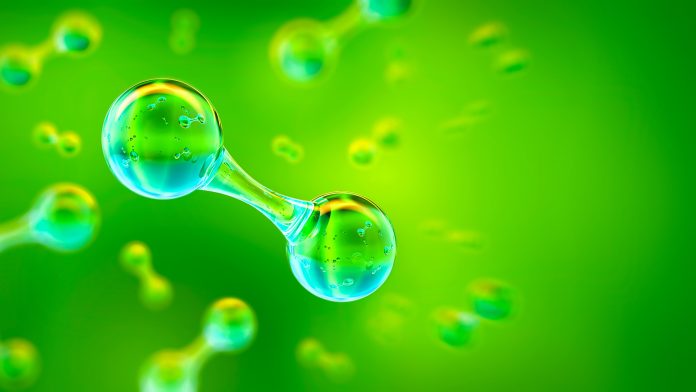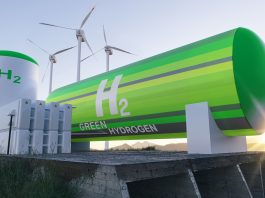Engineers have developed a solar-powered device that has brought us one step closer to being able to harvest water from the air to produce hydrogen fuel.
For decades, researchers have dreamed of a solar-powered device that can harvest water from the air to produce hydrogen fuel. This is close to becoming a reality, as EPFL chemical engineer Kevin Sivula and his team have developed a system that combines semiconductor-based technology with novel electrodes that have two key characteristics: they are porous, to maximise contact with water in the air; and transparent, to maximise sunlight exposure of the semiconductor coating. The device aims to successfully facilitate hydrogen production just by being exposed to sunlight.
The results of the study, titled ‘Transparent Porous Conductive Substrates for Gas-Phase Photoelectrochemical Hydrogen Production,’ are published in the journal Advanced Materials.
New electrodes developed for hydrogen production
The novel gas diffusion electrodes developed by the researchers are transparent, porous, and conductive, enabling hydrogen production from water in the air.
“To realise a sustainable society, we need ways to store renewable energy as chemicals that can be used as fuels and feedstocks in industry. Solar energy is the most abundant form of renewable energy, and we are striving to develop economically-competitive ways to produce solar fuels,” said Sivula of EPFL’s Laboratory for Molecular Engineering of Optoelectronic Nanomaterials and principal investigator of the study.
Technology inspired by photosynthesis
In their research for renewable fossil-free fuels, the team took inspiration from a plant’s ability to photosynthesise, where carbon dioxide and water are harvested by a plant and with a boost from the Sun’s energy, are transformed into sugars and starches. The sunlight’s energy is stored inside the sugars and starches in chemical bonds.
Sivula’s novel electrodes are coated with a light-harvesting semiconductor material, resulting in it acting like an artificial leaf that can harvest water from the air and sunlight, facilitating hydrogen production. In this case, the sunlight’s energy is stored in the form of hydrogen bonds.

Instead of building electrodes with traditional layers that are opaque to sunlight, their substrate is a 3-dimensional mesh of felted glass fibres.
Marina Caretti, lead author of the work, said: “Developing our prototype device was challenging since transparent gas-diffusion electrodes have not been previously demonstrated, and we had to develop new procedures for each step. However, since each step is relatively simple and scalable, I think that our approach will open new horizons for a wide range of applications starting from gas diffusion substrates for solar-driven hydrogen production.”
Making artificial photosynthesis possible
Previously, it has been proved that artificial photosynthesis is possible by generating hydrogen fuel from liquid water and sunlight using a device called a photoelectrochemical (PEC) cell – a device that uses incident light to stimulate a photosensitive material, like a semiconductor, immersed in a liquid solution to cause a chemical reaction. This process has its disadvantages when it comes to practical purposes, however, such as it being complicated to make large-area PEC devices that use liquid.
Sivula and his team aimed to show that PEC technology can be adapted for harvesting humidity from the air instead, leading to the development of their new gas diffusion electrode. Fuel cells have been shown to work with gases instead of liquids, but the gas diffusion electrodes used previously are opaque and incompatible with solar-powered PEC technology.
Now, the researchers are focusing on the optimisation of the system within the EU project Sun-to-X, which is dedicated to advancing this technology, and developing new ways to convert hydrogen into liquid fuels.
Creating the novel electrodes
The researchers developed the transparent gas diffusion electrodes by starting with a type of glass wool, essentially quartz fibres, and processing it into felt wafers by fusing the fibres at a high temperature. The wafer is then coated with a transparent thin film of fluorine-doped tin oxide, known for its excellent conductivity, robustness, and ease of scale-up.
From these steps, a transparent, porous, and conducting wafer is produced, essential for maximising contact with the water molecules in the air and letting photons through. The water is then coated again with a thin film of sunlight-absorbing semiconductor materials, which lets light through but appears opaque due to the large surface area of the porous substrate. This coated wafer also has the potential for hydrogen production once exposed to sunlight.
The team then built a small chamber containing the coated wafer, as well as a membrane for separating the produced hydrogen gas for measurement. Hydrogen gas is produced when the chamber is exposed to sunlight under humid conditions, showing that the concept of a transparent gas-diffusion electrode for solar-powered hydrogen gas production can be achieved.
Although the scientists did not formally study the solar-to-hydrogen conversion efficiency in their demonstration, they believe that it is modest for this prototype, and currently, less than can be achieved in liquid-based PEC cells. Based on the materials used, the maximum theoretical solar-to-hydrogen conversion efficiency of the coated wafer is 12%, whereas liquid cells have been demonstrated to have up to 19% efficiency.









